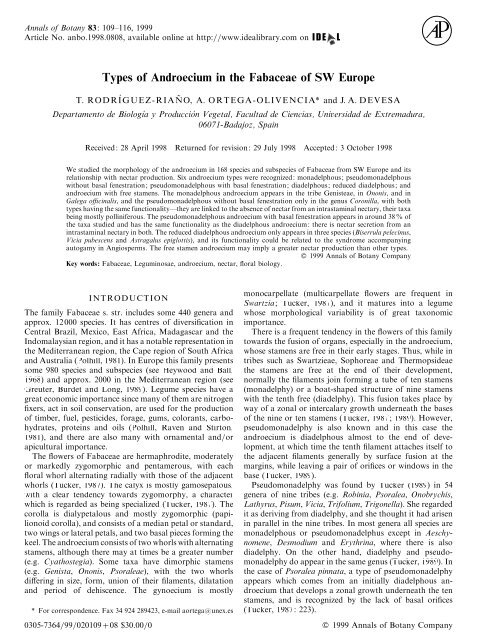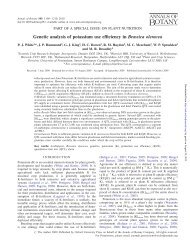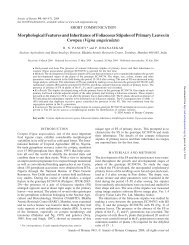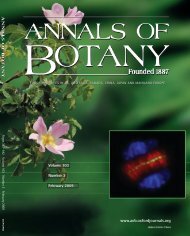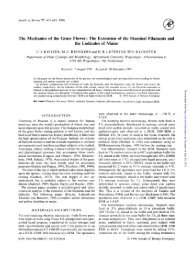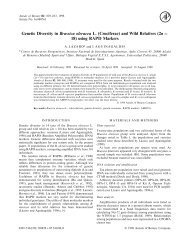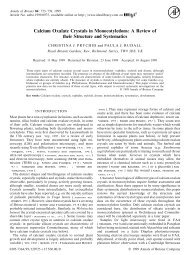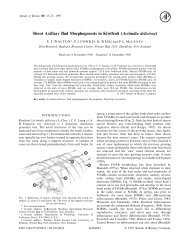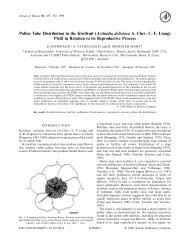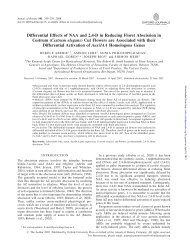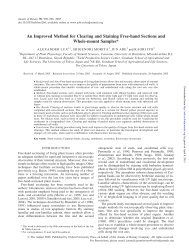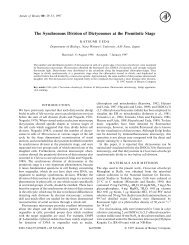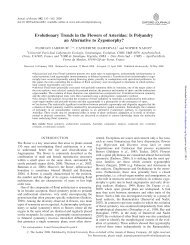Types of Androecium in the Fabaceae of SW ... - Annals of Botany
Types of Androecium in the Fabaceae of SW ... - Annals of Botany
Types of Androecium in the Fabaceae of SW ... - Annals of Botany
You also want an ePaper? Increase the reach of your titles
YUMPU automatically turns print PDFs into web optimized ePapers that Google loves.
<strong>Annals</strong> <strong>of</strong> <strong>Botany</strong> 83: 109–116, 1999<br />
Article No. anbo.1998.0808, available onl<strong>in</strong>e at http:www.idealibrary.com on<br />
<strong>Types</strong> <strong>of</strong> <strong>Androecium</strong> <strong>in</strong> <strong>the</strong> <strong>Fabaceae</strong> <strong>of</strong> <strong>SW</strong> Europe<br />
T. RODRI GUEZ-RIAN O, A. ORTEGA-OLIVENCIA* and J. A. DEVESA<br />
Departamento de Biologıa y Produccio n Vegetal, Facultad de Ciencias, Uniersidad de Extremadura,<br />
06071-Badajoz, Spa<strong>in</strong><br />
Received: 28 April 1998 Returned for revision: 29 July 1998 Accepted: 3 October 1998<br />
We studied <strong>the</strong> morphology <strong>of</strong> <strong>the</strong> androecium <strong>in</strong> 168 species and subspecies <strong>of</strong> <strong>Fabaceae</strong> from <strong>SW</strong> Europe and its<br />
relationship with nectar production. Six androecium types were recognized: monadelphous; pseudomonadelphous<br />
without basal fenestration; pseudomonadelphous with basal fenestration; diadelphous; reduced diadelphous; and<br />
androecium with free stamens. The monadelphous androecium appears <strong>in</strong> <strong>the</strong> tribe Genisteae, <strong>in</strong> Ononis, and <strong>in</strong><br />
Galega <strong>of</strong>fic<strong>in</strong>alis, and <strong>the</strong> pseudomonadelphous without basal fenestration only <strong>in</strong> <strong>the</strong> genus Coronilla, with both<br />
types hav<strong>in</strong>g <strong>the</strong> same functionality—<strong>the</strong>y are l<strong>in</strong>ked to <strong>the</strong> absence <strong>of</strong> nectar from an <strong>in</strong>trastam<strong>in</strong>al nectary, <strong>the</strong>ir taxa<br />
be<strong>in</strong>g mostly poll<strong>in</strong>iferous. The pseudomonadelphous androecium with basal fenestration appears <strong>in</strong> around 38% <strong>of</strong><br />
<strong>the</strong> taxa studied and has <strong>the</strong> same functionality as <strong>the</strong> diadelphous androecium: <strong>the</strong>re is nectar secretion from an<br />
<strong>in</strong>trastam<strong>in</strong>al nectary <strong>in</strong> both. The reduced diadelphous androecium only appears <strong>in</strong> three species (Biserrula pelec<strong>in</strong>us,<br />
Vicia pubescens and Astragalus epiglottis), and its functionality could be related to <strong>the</strong> syndrome accompany<strong>in</strong>g<br />
autogamy <strong>in</strong> Angiosperms. The free stamen androecium may imply a greater nectar production than o<strong>the</strong>r types.<br />
1999 <strong>Annals</strong> <strong>of</strong> <strong>Botany</strong> Company<br />
Key words: <strong>Fabaceae</strong>, Legum<strong>in</strong>osae, androecium, nectar, floral biology.<br />
INTRODUCTION<br />
monocarpellate (multicarpellate flowers are frequent <strong>in</strong><br />
Swartzia; Tucker, 1987), and it matures <strong>in</strong>to a legume<br />
The family <strong>Fabaceae</strong> s. str. <strong>in</strong>cludes some 440 genera and whose morphological variability is <strong>of</strong> great taxonomic<br />
approx. 12000 species. It has centres <strong>of</strong> diversification <strong>in</strong> importance.<br />
Central Brazil, Mexico, East Africa, Madagascar and <strong>the</strong> There is a frequent tendency <strong>in</strong> <strong>the</strong> flowers <strong>of</strong> this family<br />
Indomalaysian region, and it has a notable representation <strong>in</strong> towards <strong>the</strong> fusion <strong>of</strong> organs, especially <strong>in</strong> <strong>the</strong> androecium,<br />
<strong>the</strong> Mediterranean region, <strong>the</strong> Cape region <strong>of</strong> South Africa whose stamens are free <strong>in</strong> <strong>the</strong>ir early stages. Thus, while <strong>in</strong><br />
and Australia (Polhill, 1981). In Europe this family presents tribes such as Swartzieae, Sophoreae and Thermopsideae<br />
some 980 species and subspecies (see Heywood and Ball, <strong>the</strong> stamens are free at <strong>the</strong> end <strong>of</strong> <strong>the</strong>ir development,<br />
1968) and approx. 2000 <strong>in</strong> <strong>the</strong> Mediterranean region (see normally <strong>the</strong> filaments jo<strong>in</strong> form<strong>in</strong>g a tube <strong>of</strong> ten stamens<br />
Greuter, Burdet and Long, 1989). Legume species have a (monadelphy) or a boat-shaped structure <strong>of</strong> n<strong>in</strong>e stamens<br />
great economic importance s<strong>in</strong>ce many <strong>of</strong> <strong>the</strong>m are nitrogen with <strong>the</strong> tenth free (diadelphy). This fusion takes place by<br />
fixers, act <strong>in</strong> soil conservation, are used for <strong>the</strong> production way <strong>of</strong> a zonal or <strong>in</strong>tercalary growth underneath <strong>the</strong> bases<br />
<strong>of</strong> timber, fuel, pesticides, forage, gums, colorants, carbo- <strong>of</strong> <strong>the</strong> n<strong>in</strong>e or ten stamens (Tucker, 1987; 1989). However,<br />
hydrates, prote<strong>in</strong>s and oils (Polhill, Raven and Stirton, pseudomonadelphy is also known and <strong>in</strong> this case <strong>the</strong><br />
1981), and <strong>the</strong>re are also many with ornamental andor androecium is diadelphous almost to <strong>the</strong> end <strong>of</strong> deve-<br />
apicultural importance.<br />
lopment, at which time <strong>the</strong> tenth filament attaches itself to<br />
The flowers <strong>of</strong> <strong>Fabaceae</strong> are hermaphrodite, moderately <strong>the</strong> adjacent filaments generally by surface fusion at <strong>the</strong><br />
or markedly zygomorphic and pentamerous, with each marg<strong>in</strong>s, while leav<strong>in</strong>g a pair <strong>of</strong> orifices or w<strong>in</strong>dows <strong>in</strong> <strong>the</strong><br />
floral whorl alternat<strong>in</strong>g radially with those <strong>of</strong> <strong>the</strong> adjacent base (Tucker, 1989).<br />
whorls (Tucker, 1987). The calyx is mostly gamosepalous, Pseudomonadelphy was found by Tucker (1989) <strong>in</strong> 54<br />
with a clear tendency towards zygomorphy, a character genera <strong>of</strong> n<strong>in</strong>e tribes (e.g. Rob<strong>in</strong>ia, Psoralea, Onobrychis,<br />
which is regarded as be<strong>in</strong>g specialized (Tucker, 1987). The Lathyrus, Pisum, Vicia, Trifolium, Trigonella). She regarded<br />
corolla is dialypetalous and mostly zygomorphic (papi- it as deriv<strong>in</strong>g from diadelphy, and she thought it had arisen<br />
lionoid corolla), and consists <strong>of</strong> a median petal or standard, <strong>in</strong> parallel <strong>in</strong> <strong>the</strong> n<strong>in</strong>e tribes. In most genera all species are<br />
two w<strong>in</strong>gs or lateral petals, and two basal pieces form<strong>in</strong>g <strong>the</strong> monadelphous or pseudomonadelphus except <strong>in</strong> Aeschy-<br />
keel. The androecium consists <strong>of</strong> two whorls with alternat<strong>in</strong>g nomene, Desmodium and Erythr<strong>in</strong>a, where <strong>the</strong>re is also<br />
stamens, although <strong>the</strong>re may at times be a greater number diadelphy. On <strong>the</strong> o<strong>the</strong>r hand, diadelphy and pseudo-<br />
(e.g. Cyathostegia). Some taxa have dimorphic stamens monadelphy do appear <strong>in</strong> <strong>the</strong> same genus (Tucker, 1989). In<br />
(e.g. Genista, Ononis, Psoraleae), with <strong>the</strong> two whorls <strong>the</strong> case <strong>of</strong> Psoralea p<strong>in</strong>nata, a type <strong>of</strong> pseudomonadelphy<br />
differ<strong>in</strong>g <strong>in</strong> size, form, union <strong>of</strong> <strong>the</strong>ir filaments, dilatation appears which comes from an <strong>in</strong>itially diadelphous an-<br />
and period <strong>of</strong> dehiscence. The gynoecium is mostly droecium that develops a zonal growth underneath <strong>the</strong> ten<br />
stamens, and is recognized by <strong>the</strong> lack <strong>of</strong> basal orifices<br />
* For correspondence. Fax 34 924 289423, e-mail aortegaunex.es (Tucker, 1987: 223).<br />
0305-73649902010908 $30.000 1999 <strong>Annals</strong> <strong>of</strong> <strong>Botany</strong> Company
110 Rodrıguez-Rian o et al.—<strong>Androecium</strong> <strong>in</strong> <strong>Fabaceae</strong><br />
Table 1. <strong>Types</strong> <strong>of</strong> androecium and presence () or absence () <strong>of</strong> nectar <strong>in</strong> <strong>the</strong> <strong>Fabaceae</strong> taxa studied<br />
Taxa Nectar <strong>Androecium</strong> Taxa Nectar <strong>Androecium</strong><br />
Tribe Vicieae<br />
Vicia L.<br />
V. benghalensis L. Pm()S<br />
V. cracca subsp. tenuifolia (Roth) Pm()S<br />
Gaud<strong>in</strong><br />
V. disperma DC. Pm()S<br />
V. hirsuta (L.) S. F. Gray Pm()S<br />
V. lutea L. subsp. lutea Pm()S<br />
V. lutea subsp. estita (Boiss.) Rouy Pm()S<br />
V. pariflora Cav. Pm()S<br />
V. peregr<strong>in</strong>a L. Pm()S<br />
V. pubescens (DC.) L<strong>in</strong>k* Dr<br />
V. satia subsp. nigra (L.) Ehrh Pm()S<br />
V. satia L. subsp. satia Pm()S<br />
V. icioides (Desf.) Cout<strong>in</strong>ho<br />
V. illosa subsp. eriocarpa (Hausskn.)<br />
P. W. Ball<br />
Pm()S<br />
V. illosa subsp. aria (Host) Corb.<br />
Lathyrus L.<br />
Pm()S<br />
L. angulatus L. Pm()S<br />
L. annuus L. Pm()S<br />
L. aphaca L. Pm()S<br />
L. cicera L. Pm()S<br />
L. clymenum L. Pm()S<br />
L. hirsutus L. Pm()S<br />
L. latifolius L. Pm()S<br />
L. l<strong>in</strong>ifolius (Reichard) Ba sler Pm()S<br />
L. niger (L.) Bernh Pm()S<br />
L. sphaericus L.* Pm()S<br />
L. t<strong>in</strong>gitanus L.<br />
Pisum L.<br />
Pm()S<br />
P. satium subsp. elatius (Bieb.)<br />
Ascherlon Graebner<br />
Tribe Loteae<br />
Lotus L.<br />
Pm()S<br />
L. angustissimus L. D<br />
L. conimbricensis Brot. D<br />
L. corniculatus L. D<br />
L. glareosus Boiss. & Reuter D<br />
L. pedunculatus Cav. D<br />
L. subbiflorus subsp. castellanus<br />
(Boiss. & Reuter) P. W. Ball<br />
D<br />
L. subbiflorus Lag. subsp. subbiflorus D<br />
L. ulig<strong>in</strong>osus Schkuhr<br />
Dorycnium Miller<br />
D<br />
D. pentaphyllum Scop. D<br />
D. rectum (L.) Ser.<br />
Anthyllis L.<br />
D-Pm()S<br />
A. cytisoides L. Pm()S<br />
A. ulneraria subsp. maura (Beck.) Maire<br />
Dorycnopsis Boiss.<br />
Pm()S<br />
D. gerardii (L.) Boiss.*<br />
Hymenocarpos Savi<br />
Pm()S<br />
H. cornic<strong>in</strong>a (L.) Lassen* Pm()S<br />
H. hamosus (Desf.) Lassen Pm()S<br />
H. hispanicus Lassen<br />
Tripodion Medik.<br />
Pm()S<br />
T. tetraphyllum (L.) Fourr.<br />
Tribe Hedysareae<br />
Hedysarum L.<br />
D<br />
H. coronarium L.<br />
Onobrychis Miller<br />
D<br />
O. humilis (Loefl.) G. Lo pez D<br />
O. iciifolia Scop.<br />
Ornithopus L.<br />
D<br />
O. compressus L. D<br />
O. perspusillus L.* D<br />
O. p<strong>in</strong>natus (Miller) Druce D<br />
O. satius L.<br />
Coronilla L.<br />
D<br />
C. juncea L. Pm()<br />
C. repanda subsp. dura (Cav.) Cout<strong>in</strong>ho Pm()<br />
C. scorpioides (L.) Koch Pm()<br />
C. alent<strong>in</strong>a subsp. glauca (L.) Batt.<br />
Hippocrepis L.<br />
Pm()<br />
H. ciliata Willd. D<br />
H. scabra DC.<br />
Scorpiurus L.<br />
D<br />
S. muricatus L. D<br />
S. ermiculatus L.<br />
Tribe Trifolieae<br />
Trifolium L.<br />
D<br />
T. angustifolium L. Pm()F<br />
T. arense L. D<br />
T. bocconei Savi wd Pm()F<br />
T. campestre Schreber* Pm()F<br />
T. cernuum Brot. D<br />
T. cherleri L. D<br />
T. dubium Sibth. Pm()F<br />
T. fragiferum L.* Pm()F<br />
T. gemellum Pourr. ex Willd. D<br />
T. glomeratum L. D<br />
T. isthmocarpum Brot. D<br />
T. lappaceum L.* Pm()F<br />
T. ligusticum L. wd Pm()F<br />
T. mutabile Portensch.* Pm()F<br />
T. ochroleucon Hudson Pm()F<br />
T. pratense L. Pm()F<br />
T. repens L. D<br />
T. resup<strong>in</strong>atum L. D<br />
T. scabrum L. Pm()F<br />
T. spumosum L. D<br />
T. squamosum L.* D<br />
T. stellatum L. Pm()F<br />
T. striatum L.* D<br />
T. strictum L. wd Pm()F<br />
T. subterraneum subsp. brachycalyc<strong>in</strong>um<br />
Katznelson & Morley<br />
Pm()F<br />
T. suffocatum L.* D<br />
T. tomentosum L.*<br />
Medicago L.<br />
D<br />
M. arabica (L.) Hudson* Pm()F<br />
M. coronata (L.) Bartal.* Pm()F<br />
M. doliata Carm<strong>in</strong>g. subsp. doliata Pm()F<br />
M. doliata subsp. muricata<br />
(Bentham) Heyn<br />
Pm()F<br />
M. littoralis Loisel. Pm()F<br />
M. lupul<strong>in</strong>a L.* Pm()F<br />
M. m<strong>in</strong>ima var. recta (Desf.) Burnat Pm()F<br />
M. orbicularis (L.) Bartal. Pm()F<br />
M. polymorpha L. Pm()F<br />
M. rigidula (L.) All. Pm()F<br />
M. satia L. Pm()F<br />
M. tornata (L.) Miller Pm()F<br />
M. truncatula Gaertner<br />
Trigonella L.<br />
Pm()F<br />
T. monspeliaca L. D<br />
T. polyceratia L.*<br />
Melilotus Miller<br />
D<br />
M. albus Medik. D<br />
M. elegans Salzm. ex Ser. D<br />
M. <strong>in</strong>dicus (L.) All. D<br />
M. sulcatus Desf.* D
Rodrıguez-Rian o et al.—<strong>Androecium</strong> <strong>in</strong> <strong>Fabaceae</strong> 111<br />
Table 1. (cont.)<br />
Taxa Nectar <strong>Androecium</strong> Taxa Nectar <strong>Androecium</strong><br />
Ononis L.<br />
O. biflora Desf. M<br />
O. broterana DC. M<br />
O. c<strong>in</strong>trana Brot. M<br />
O. diffusa Ten. M<br />
O. laxiflora Desf. M<br />
O. natrix L.<br />
O. pendula subsp. boissieri (S irj.) Devesa<br />
<br />
<br />
M<br />
M<br />
O. p<strong>in</strong>nata Brot. M<br />
O. pubescens L. M<br />
O. recl<strong>in</strong>ata subsp. mollis (Savi) Be gu<strong>in</strong>ot M<br />
O. recl<strong>in</strong>ata L. subsp. recl<strong>in</strong>ata M<br />
O. sp<strong>in</strong>osa subsp. australis<br />
(S irj.) Greauter & Burdet<br />
M<br />
O. iscosa subsp. brachycarpa (DC.) M<br />
Batt.<br />
O. iscosa subsp. crotalarioides<br />
(Cosson) S irj.<br />
Tribe Genisteae<br />
Genista L.<br />
M<br />
G. anglica L. M<br />
G. c<strong>in</strong>erascens Lange M<br />
G. falcata Brot. M<br />
G. florida L. M<br />
G. hirsuta Vahl M<br />
G. polyanthos subsp. hystrix (Lange) M<br />
Franco<br />
G. tournefortii Spach M<br />
G. triacanthos Brot. M<br />
G. tridentata L. M<br />
G. umbellata (L’He r.) Poiret<br />
Retama Raf<strong>in</strong>.<br />
M<br />
R. monosperma (L.) Boiss. wd M<br />
R. sphaerocarpa (L.) Boiss.<br />
Spartium L.<br />
M<br />
S. junceum L.<br />
Ech<strong>in</strong>ospartum (Spach) Rothm.<br />
M<br />
E. barnadesii subsp. dorsisericeum M<br />
G. Lo pez<br />
Ulex L.<br />
U. eriocladus C. Vicioso M<br />
U. m<strong>in</strong>or Roth<br />
Cytisus L.<br />
M<br />
C. arboreus subsp. baeticus (Webb) M<br />
Maire<br />
C. balansae subsp. europaeus M<br />
(G. Lo pez & Jarvis) Mun oz Garmendia<br />
C. grandiflorus (Brot.) DC. M<br />
C. multiflorus (L’He r) Sweet M<br />
C. scoparius (L.) L<strong>in</strong>k M<br />
C. striatus (Hill) Rothm. M<br />
M, Monadelphous androecium; Pm(), pseudomonadelphous without basal fenestration; Pm() S, pseudomonadelphous with basal<br />
fenestration (stamen A1 superposed); Pm()F, pseudomonadelphous with basal fenestration (stamen A1 fused); D, diadelphous; Dr, reduced<br />
diadelphous; F, free.<br />
* Potentially nectariferous taxa; wd, without data.<br />
Whatever <strong>the</strong> type <strong>of</strong> androecium, <strong>the</strong> fusion <strong>of</strong> <strong>the</strong><br />
stamens <strong>in</strong> this family confers an important adaptive<br />
advantage (Polhill et al., 1981) by form<strong>in</strong>g <strong>the</strong> stam<strong>in</strong>al<br />
column and limit<strong>in</strong>g <strong>the</strong> range <strong>of</strong> poll<strong>in</strong>ators that can work<br />
<strong>the</strong> flower. Many <strong>in</strong>stances <strong>of</strong> fusion are specifically<br />
associated with poll<strong>in</strong>ation mechanisms, probably as <strong>the</strong><br />
result <strong>of</strong> coevolution, although it is not known whe<strong>the</strong>r <strong>the</strong>y<br />
are correlated (Tucker, 1987).<br />
Adenocarpus DC.<br />
A. complicatus subsp. anisochilus<br />
(Boiss.) Franco<br />
M<br />
A. complicatus (L.) Gay subsp.<br />
M<br />
complicatus<br />
A. hispanicus subsp. argyrophyllus<br />
Rivas Goday<br />
M<br />
A. hispanicus subsp. gredensis<br />
Rivas Martınez & Belmonte<br />
M<br />
A. telonensis Loisel.<br />
Argyrolobium Ecklon & Zeyher<br />
M<br />
A. zanonii (Turra) P. W. Ball<br />
Lup<strong>in</strong>us L.<br />
M<br />
L. albus L. M<br />
L. angustifolius L. M<br />
L. hispanicus subsp. bicolor Mer<strong>in</strong>o M<br />
L. hispanicus Boiss. & Reuter<br />
subsp. hispanicus<br />
M<br />
L. luteus L. M<br />
L. micranthus Guss.<br />
Tribe Galegeae<br />
Galega L.<br />
M<br />
G. <strong>of</strong>fic<strong>in</strong>alis L.<br />
Biserrula L.<br />
M<br />
B. pelec<strong>in</strong>us L.*<br />
Colutea L.<br />
Dr<br />
C. atlantica Browicz<br />
Astragalus L.<br />
D<br />
A. cymbicarpos Brot. D<br />
A. ech<strong>in</strong>atus Murray D<br />
A. epiglottis L. subsp. epiglottis* Dr<br />
A. glaux L. D<br />
A. glyciphyllos L. D<br />
A. hamosus L.* D<br />
A. lusitanicus Lam. D<br />
A. nitidiflorus Jime nez & Pau D<br />
A. stella Gouan*<br />
Tribe Psoraleae<br />
Cullen Medik.<br />
D<br />
C. americanum (L.) Rydb.<br />
Bitum<strong>in</strong>aria Fabr.<br />
Pm()F<br />
B. bitum<strong>in</strong>osa (L.) Stirton<br />
Tribe Thermopsideae<br />
Anagyris L.<br />
Pm()F<br />
A. foetida L.<br />
Tribe Rob<strong>in</strong>ieae<br />
Rob<strong>in</strong>ia L.<br />
F<br />
R. pseudacacia L. Pm()F<br />
Also <strong>of</strong> <strong>in</strong>terest <strong>in</strong> flower biology is <strong>the</strong> type <strong>of</strong> reward<br />
<strong>of</strong>fered to pollen vectors. Many members <strong>of</strong> this family <strong>of</strong>fer<br />
nectar which is secreted <strong>in</strong> <strong>the</strong> <strong>in</strong>nermost parts <strong>of</strong> <strong>the</strong> base <strong>of</strong><br />
<strong>the</strong> stam<strong>in</strong>al filaments and accumulates <strong>in</strong> <strong>the</strong> space created<br />
between <strong>the</strong> stamens and <strong>the</strong> pistil (Bonnier, 1879; Mu ller,<br />
1883). Access to <strong>the</strong> nectar is by way <strong>of</strong> <strong>the</strong> space created by<br />
one <strong>of</strong> <strong>the</strong> ten stamens which orig<strong>in</strong>ates two entrances at its<br />
base, so that <strong>in</strong> pr<strong>in</strong>ciple one might th<strong>in</strong>k that only species
112 Rodrıguez-Rian o et al.—<strong>Androecium</strong> <strong>in</strong> <strong>Fabaceae</strong><br />
A2<br />
B3<br />
B1<br />
A4<br />
A1<br />
B5<br />
Fig. 1. Floral diagram <strong>of</strong> a diadelphous androecium. The large ovals<br />
represent <strong>the</strong> outer whorl (stamens B1-B5) and <strong>the</strong> small ovals <strong>the</strong> <strong>in</strong>ner<br />
whorl (A1-A5). A1, Vexillary stamen.<br />
with a diadelphous androecium would be nectariferous. But<br />
this is not always so. Although <strong>the</strong>re are not many studies<br />
<strong>of</strong> <strong>the</strong> <strong>Fabaceae</strong> nectaries, those analysed to date are<br />
discoidal ( annular), appear<strong>in</strong>g around <strong>the</strong> base <strong>of</strong> <strong>the</strong><br />
carpel, usually associated with <strong>the</strong> stam<strong>in</strong>al tube, <strong>in</strong> most<br />
cases possess<strong>in</strong>g stomata and <strong>in</strong>terpreted as an excrescence<br />
<strong>of</strong> <strong>the</strong> receptacle ra<strong>the</strong>r than as a reduced additional<br />
stam<strong>in</strong>al whorl (Bonnier, 1879; Waddle and Lersten, 1973;<br />
Teuber et al., 1980). In content, <strong>the</strong> nectar <strong>of</strong> most legumes<br />
is sucrose-rich (Furgala, Gochnauer and Holdaway, 1958;<br />
Southwick, Loper and Sadwick, 1981) and <strong>the</strong>refore very<br />
much appreciated by honeybees and bumblebees. These<br />
are <strong>the</strong> commonest poll<strong>in</strong>ators, which also visit nonnectariferous<br />
species, attracted by <strong>the</strong> high prote<strong>in</strong> quality<br />
<strong>of</strong> <strong>the</strong>ir pollen (Leppik, 1966; Day et al., 1990).<br />
The pr<strong>in</strong>cipal objectives <strong>of</strong> <strong>the</strong> present work were: (1) to<br />
study <strong>the</strong> degree <strong>of</strong> fusion <strong>of</strong> <strong>the</strong> stam<strong>in</strong>al filaments <strong>in</strong> <strong>the</strong><br />
<strong>Fabaceae</strong> <strong>of</strong> <strong>SW</strong> Europe; and (2) to <strong>in</strong>vestigate whe<strong>the</strong>r<br />
<strong>the</strong>re is a functional relationship between <strong>the</strong> type <strong>of</strong><br />
androecium and nectar production. The authority for each<br />
species or subspecies studied is listed <strong>in</strong> Table 1.<br />
MATERIALS AND METHODS<br />
A total <strong>of</strong> 168 taxa (158 species and ten subspecies) were<br />
collected <strong>in</strong> 428 natural populations, analys<strong>in</strong>g a m<strong>in</strong>imum<br />
<strong>of</strong> three populations per taxon (except <strong>in</strong> a few cases where<br />
only one or two populations were available) and some ten<br />
flowers per population. The study area is located <strong>in</strong> <strong>SW</strong><br />
Spa<strong>in</strong> (region <strong>of</strong> Extremadura), bounded by <strong>the</strong> Sistema<br />
A5<br />
B2<br />
A3<br />
B4<br />
Central to <strong>the</strong> north (maximum altitude 2401 m) and <strong>the</strong><br />
Sierra Morena (maximum altitude 1104 m) to <strong>the</strong> south,<br />
with a broad penepla<strong>in</strong> between <strong>the</strong>m with scattered ranges<br />
<strong>of</strong> hills. This extensive region is crossed by two <strong>of</strong> <strong>the</strong> most<br />
important rivers <strong>in</strong> Spa<strong>in</strong>, <strong>the</strong> Tagus and <strong>the</strong> Guadiana. The<br />
climate is Mediterranean, be<strong>in</strong>g markedly seasonal. The<br />
vegetation consists <strong>of</strong> woodland formations <strong>of</strong> holm oak<br />
(Quercus ilex subsp. ballota Q. rotundifolia), cork oak (Q.<br />
suber) and deciduous oak (Q. pyrenaica), and above all <strong>of</strong><br />
dehesas <strong>of</strong> <strong>the</strong>se same species—<strong>the</strong>se are graz<strong>in</strong>gcropland<br />
systems ma<strong>in</strong>ta<strong>in</strong>ed traditionally throughout <strong>the</strong> west <strong>of</strong> <strong>the</strong><br />
Iberian Pen<strong>in</strong>sula. There is an abundance <strong>of</strong> riparian<br />
woodland, and extensive scrublands with many species,<br />
foremost be<strong>in</strong>g <strong>the</strong> <strong>Fabaceae</strong> shrubs <strong>of</strong> <strong>the</strong> tribe Genisteae.<br />
There are also large areas <strong>of</strong> basophile or acidophile<br />
pastures, with a major component <strong>of</strong> <strong>the</strong>ir floristic composition<br />
be<strong>in</strong>g <strong>Fabaceae</strong> herbs (Devesa, 1995).<br />
The study was performed on flowers and flower buds<br />
preserved <strong>in</strong> 70% alcohol. For each population, flower buds<br />
<strong>of</strong> different ages and an<strong>the</strong>sic flowers were dissected under<br />
a stereomicroscope, and <strong>the</strong> perianth parts elim<strong>in</strong>ated. The<br />
morphology <strong>of</strong> <strong>the</strong> androecium was <strong>the</strong>n observed, not<strong>in</strong>g<br />
<strong>the</strong> type <strong>of</strong> fusion <strong>of</strong> <strong>the</strong> stam<strong>in</strong>al filaments and whe<strong>the</strong>r or<br />
not basal fenestration was present. It was also studied on<br />
dry material deposited <strong>in</strong> <strong>the</strong> UNEX herbarium, but <strong>in</strong> this<br />
case <strong>the</strong> pseudomonadelphous condition was more difficult<br />
to dist<strong>in</strong>guish, which might expla<strong>in</strong> its lack <strong>of</strong> recognition <strong>in</strong><br />
taxonomic descriptions. Throughout <strong>the</strong> rema<strong>in</strong>der <strong>of</strong> <strong>the</strong><br />
text, A1 will refer to <strong>the</strong> vexillary stamen (Fig. 1). In<br />
previous studies (Ortega-Olivencia et al., 1997; Lo pez et al.,<br />
1998; Rodrıguez-Rian o, Ortega-Olivencia and Devesa,<br />
1999) on <strong>the</strong>se same populations and species, nectar<br />
production was quantified; those results are considered here<br />
<strong>in</strong> relation to <strong>the</strong> type <strong>of</strong> androecium.<br />
The taxa sampled belong to eight native tribes <strong>in</strong> <strong>the</strong><br />
territory (n<strong>in</strong>e if Rob<strong>in</strong>ia pseudacacia is <strong>in</strong>cluded). This latter<br />
is a foreign element which is very frequent <strong>in</strong> urban and<br />
rural landscapes as it has acclimatized to <strong>the</strong> environmental<br />
conditions <strong>of</strong> this territory. Relative to <strong>the</strong> flora <strong>of</strong> Europe,<br />
our sample represents around 17% <strong>of</strong> <strong>the</strong> species (and<br />
subspecies) and 563% <strong>of</strong> <strong>the</strong> tribes. The taxonomic criterion<br />
followed at <strong>the</strong> tribe level is that <strong>of</strong> Domınguez (1987).<br />
Statistical analysis<br />
As it was not possible to normalize <strong>the</strong> data correspond<strong>in</strong>g<br />
to <strong>the</strong> production <strong>of</strong> nectar <strong>in</strong> groups with different types <strong>of</strong><br />
androecium, non-parametric tests were used (Sokal and<br />
Rohlf, 1979).<br />
RESULTS<br />
The follow<strong>in</strong>g types <strong>of</strong> androecium were dist<strong>in</strong>guished <strong>in</strong> <strong>the</strong><br />
study sample accord<strong>in</strong>g to <strong>the</strong> degree <strong>of</strong> fusion <strong>of</strong> <strong>the</strong><br />
filaments: (a) monadelphous (Fig. 2A). It is present <strong>in</strong> <strong>the</strong><br />
tribe Genisteae, <strong>the</strong> genus Ononis, and Galega <strong>of</strong>fic<strong>in</strong>alis;(b)<br />
pseudomonadelphous, without basal fenestration: with n<strong>in</strong>e<br />
fused stamens and one free stamen (A1) cover<strong>in</strong>g <strong>the</strong> gap<br />
left by <strong>the</strong> union <strong>of</strong> <strong>the</strong> rest <strong>of</strong> <strong>the</strong> filaments, but with no
Rodrıguez-Rian o et al.—<strong>Androecium</strong> <strong>in</strong> <strong>Fabaceae</strong> 113<br />
Fig. 2. <strong>Types</strong> <strong>of</strong> androecium: A, monadelphous (Cytisus grandiflorus); B, unfenestrated pseudomonadelphous (Coronilla alent<strong>in</strong>a subsp. glauca);<br />
C, basally fenestrated pseudomonadelphous (Vicia benghalensis); D, diadelphous (Astragalus lusitanicus); E, reduced diadelphous (Biserrula<br />
pelec<strong>in</strong>us); F, free (Anagyris foetida). Bars 1 mm except B and E where bar 05 mm.<br />
formation <strong>of</strong> fenestration at <strong>the</strong> base (Fig. 2B). This appears<br />
only <strong>in</strong> <strong>the</strong> genus Coronilla; (c) pseudomonadelphous, with<br />
basal fenestration: as <strong>the</strong> preced<strong>in</strong>g case, but with <strong>the</strong> free<br />
stamen (A1) present<strong>in</strong>g a curvature at its base permitt<strong>in</strong>g<br />
<strong>the</strong> formation <strong>of</strong> two basal orifices (Fig. 2C). The coupl<strong>in</strong>g<br />
<strong>of</strong> this stamen to <strong>the</strong> stam<strong>in</strong>al tube varies from a simple<br />
superposition (e.g. Lathyrus) to a complete fusion along <strong>the</strong><br />
length <strong>of</strong> <strong>the</strong> tube (e.g. Medicago) except at <strong>the</strong> basal part. It<br />
is also represented <strong>in</strong> Vicia (except V. pubescens), Pisum,<br />
some species <strong>of</strong> Trifolium, Rob<strong>in</strong>ia, Dorycnopsis, Dorycnium<br />
rectum, Anthyllis, Hymenocarpos, Cullen and Bitum<strong>in</strong>aria;<br />
(d) diadelphous (Fig. 2D). It appears <strong>in</strong> some species <strong>of</strong><br />
Trifolium, Melilotus, Trigonella, Astragalus (except A.<br />
epiglottis subsp. epiglottis), Hedysarum, Hippocrepis, Onob-<br />
rychis (at times <strong>the</strong> free stamen is fused to <strong>the</strong> rest),<br />
Ornithopus, Scorpiurus, Lotus, Tripodion, Dorycnium pentaphyllum<br />
and one population <strong>of</strong> D. rectum, and Colutea<br />
atlantica; (e) reduced diadelphous: similar to <strong>the</strong> previous<br />
case but with <strong>the</strong> disappearance <strong>of</strong> all <strong>the</strong> an<strong>the</strong>rs <strong>of</strong> <strong>the</strong><br />
lower whorl with only vestiges persist<strong>in</strong>g <strong>in</strong> which it is at<br />
times possible to observe occasional pollen gra<strong>in</strong>s (Fig. 2E).<br />
This type is presented by Biserrula pelec<strong>in</strong>us, Vicia pubescens<br />
and Astragalus epiglottis; (f ) free: all <strong>the</strong> stamens rema<strong>in</strong><br />
free (Fig. 2F). It only appears <strong>in</strong> Anagyris foetida.<br />
The type <strong>of</strong> androecium <strong>of</strong> each taxon is listed <strong>in</strong> Table 1,<br />
toge<strong>the</strong>r with an <strong>in</strong>dication <strong>of</strong> whe<strong>the</strong>r it is nectariferous or<br />
not. The nectar is secreted by an annular nectary which is<br />
most <strong>of</strong>ten <strong>in</strong>trastam<strong>in</strong>al, i.e. situated between <strong>the</strong> andro-
114 Rodrıguez-Rian o et al.—<strong>Androecium</strong> <strong>in</strong> <strong>Fabaceae</strong><br />
ecium and <strong>the</strong> gynoecium, and whose presence or absence <strong>in</strong><br />
this case is closely associated with <strong>the</strong> type <strong>of</strong> androecium<br />
possessed by <strong>the</strong> taxa.<br />
Taxa with a monadelphous or pseudomonadelphous type<br />
<strong>of</strong> androecium without basal fenestration do not produce<br />
nectar s<strong>in</strong>ce <strong>the</strong>y have no <strong>in</strong>trastam<strong>in</strong>al nectary, except for<br />
Retama sphaerocarpa <strong>in</strong> which nectar is produced by an<br />
extrastam<strong>in</strong>al nectary (Lo pez et al., 1998). The rema<strong>in</strong><strong>in</strong>g<br />
taxa with o<strong>the</strong>r types <strong>of</strong> androecium may be regarded as<br />
potentially nectariferous, even though it has not been<br />
possible to quantify <strong>the</strong> nectar <strong>in</strong> some populations ei<strong>the</strong>r<br />
because <strong>of</strong> <strong>the</strong> methodology (storage <strong>in</strong> bags for 24 h with<br />
possible evaporation or crystallization <strong>of</strong> nectar) or because<br />
it was too <strong>in</strong>conspicuous to be measured.<br />
The species that produced most nectar was Anagyris<br />
foetida (x 2612 µl). This production was significantly<br />
greater (Mann-Whitney U test 655, P 0001) than that<br />
<strong>of</strong> <strong>the</strong> species next <strong>in</strong> importance – Pisum satium (x <br />
9767 µl), Lathyrus latifolius (x 953 µl) and Colutea<br />
atlantica (x 8167 µl; Rodrıguez-Rian o et al., 1999).<br />
Moreover, Anagyris foetida is <strong>the</strong> only species <strong>of</strong> those<br />
studied with free stamens. No significant differences were<br />
found (Mann-Whitney U test 10990, P 005) between<br />
<strong>the</strong> nectar production <strong>of</strong> taxa with diadelphous androecia (x<br />
072 µl, n 39) and that <strong>of</strong> taxa with a basally fenestrated<br />
pseudomonadelphous type <strong>of</strong> androecium (x 091 µl,<br />
n 50).<br />
We now list androecium types and nectar production by<br />
tribe (see Table 1).<br />
Tribe Vicieae<br />
All <strong>the</strong> species studied possessed a basally fenestrated<br />
pseudomonadelphous type <strong>of</strong> androecium (Fig. 2C). The<br />
only exception to this type <strong>of</strong> androecium appeared <strong>in</strong> V.<br />
pubescens, which possessed <strong>the</strong> reduced diadelphous type.<br />
All <strong>the</strong> species studied produced nectar (mean value for <strong>the</strong><br />
tribe 0822 µl), and while <strong>the</strong> amount could not be<br />
quantified <strong>in</strong> Lathyrus sphaericus, <strong>in</strong>tuitively we felt this to<br />
be a potentially nectariferous taxon.<br />
Tribe Loteae<br />
Two types <strong>of</strong> androecium were observed: (1) basally<br />
fenestrated pseudomonadelphous (Hymenocarpos, Anthyllis,<br />
Dorycnopsis); and (2) diadelphous (Lotus, Tripodion and<br />
Dorycnium pentaphyllum). Dorycnium rectum, however, is <strong>in</strong><br />
an <strong>in</strong>termediate situation, s<strong>in</strong>ce one <strong>of</strong> <strong>the</strong> populations<br />
studied had a diadelphous androecium and <strong>the</strong> o<strong>the</strong>r<br />
pseudomonadelphous which even had no apparent basal<br />
fenestration. All <strong>the</strong> species <strong>of</strong> <strong>the</strong> tribe that were studied<br />
were potentially nectariferous. The mean value <strong>of</strong> nectar<br />
production for <strong>the</strong> tribe is 0306 µl, although <strong>in</strong> Dorycnopsis<br />
gerardii and Hymenocarpos cornic<strong>in</strong>a, which<br />
are potentially nectariferous, <strong>the</strong> amount could not be<br />
quantified.<br />
Tribe Hedysareae<br />
Two types <strong>of</strong> androecium were observed: (1) pseudomonadelphous<br />
without basal fenestration, with <strong>the</strong> A1<br />
stamen wholly occupy<strong>in</strong>g <strong>the</strong> gap left by <strong>the</strong> filament tube<br />
and very lightly fused to it, present only <strong>in</strong> Coronilla (Fig.<br />
2B); and (2) diadelphous (<strong>the</strong> rema<strong>in</strong><strong>in</strong>g taxa). In <strong>the</strong> case <strong>of</strong><br />
<strong>the</strong> genus Onobrychis, <strong>the</strong>re is a slight superposition <strong>of</strong> <strong>the</strong><br />
free stamen (which is somewhat flattened from <strong>the</strong> basal<br />
part, with <strong>the</strong> flatten<strong>in</strong>g disappear<strong>in</strong>g gradually towards <strong>the</strong><br />
apex). All <strong>the</strong> species are nectariferous or at least potentially<br />
so, with a mean value for <strong>the</strong> tribe <strong>of</strong> 0204 µl. In <strong>the</strong><br />
genus Coronilla, however, no nectar production was<br />
observed.<br />
Tribe Trifolieae<br />
The follow<strong>in</strong>g types <strong>of</strong> androecium were recognized: (1)<br />
monadelphous (Ononis); (2) basally fenestrated pseudomonadelphous<br />
with <strong>the</strong> A1 stamen practically fused along<br />
<strong>the</strong> entire length <strong>of</strong> <strong>the</strong> tube except at <strong>the</strong> basal zone<br />
(Medicago) or only at a small upper portion <strong>of</strong> <strong>the</strong><br />
androecium (some species <strong>of</strong> Trifolium); and (3) diadelphous<br />
(some species <strong>of</strong> Trifolium and Trigonella). All <strong>the</strong> genera<br />
are nectariferous or potentially nectariferous, except for<br />
Ononis which is poll<strong>in</strong>iferous. The mean value <strong>of</strong> <strong>the</strong> volume<br />
<strong>of</strong> nectar produced by <strong>the</strong> tribe is 00301 µl.<br />
Tribe Genisteae<br />
The androecium is always monadelphous (Fig. 2A),<br />
which means <strong>the</strong> absence <strong>of</strong> an <strong>in</strong>trastam<strong>in</strong>al nectary.<br />
Nectar is only secreted when <strong>the</strong> nectary is extrastam<strong>in</strong>al, as<br />
is <strong>the</strong> case <strong>in</strong> Retama sphaerocarpa <strong>in</strong> which <strong>the</strong> mean<br />
production per flower was observed to be 00901 µl.<br />
Tribe Galegeae<br />
Three types <strong>of</strong> androecium were observed: (1) monadelphous<br />
(Galega <strong>of</strong>fic<strong>in</strong>alis); (2) diadelphous (Colutea<br />
atlantica and Astragalus—except A. epiglottis; Fig. 2D);<br />
and (3) reduced diadelphous (Astragalus epiglottis and<br />
Biserrula pelec<strong>in</strong>us; Fig. 2E). All <strong>the</strong> species were found to<br />
be nectariferous except for Galega <strong>of</strong>fic<strong>in</strong>alis which is<br />
poll<strong>in</strong>iferous. However, <strong>in</strong> <strong>the</strong> taxa with reduced diadelphous<br />
androecia, which are potentially nectariferous, no<br />
nectar was observed to be present. It had evaporated or<br />
been reabsorbed, as seems to have occurred <strong>in</strong> many o<strong>the</strong>r<br />
taxa with small flowers. In this tribe <strong>the</strong> mean nectar<br />
production per flower was 2246 µl.<br />
Tribe Psoraleae<br />
The two species studied possessed a pseudomonadelphous<br />
androecium with basal fenestration. The mean production<br />
<strong>of</strong> nectar per flower <strong>in</strong> <strong>the</strong> tribe was 0705 µl.<br />
The o<strong>the</strong>r two tribes, Thermopsidaea and Rob<strong>in</strong>ieae are<br />
each represented by a s<strong>in</strong>gle species <strong>in</strong> Spa<strong>in</strong> (see Table 1).<br />
DISCUSSION<br />
The type <strong>of</strong> androecium is one <strong>of</strong> <strong>the</strong> most important floral<br />
characters <strong>of</strong> <strong>the</strong> family with regard to its systematics and<br />
reproductive biology. In this respect, <strong>in</strong> <strong>the</strong> modern as <strong>in</strong> <strong>the</strong>
older flora (e.g. Heywood and Ball, 1968; Davis, 1970;<br />
Pignatti, 1982; Gu<strong>in</strong>ochet and Vilmor<strong>in</strong>, 1984; Clapham,<br />
Tut<strong>in</strong> and Moore, 1987; Domınguez, 1987) only three types<br />
have been recognized <strong>in</strong> <strong>the</strong> family (free stamens, monadelphous<br />
and diadelphous). More recently, Tucker (1987,<br />
1989) described <strong>the</strong> existence <strong>of</strong> <strong>the</strong> pseudomonadelphous<br />
androecium. The present study documents <strong>the</strong> occurrence<br />
<strong>of</strong> <strong>the</strong>se androecial types <strong>in</strong> 165 Spanish species (and<br />
subspecies), as well as <strong>the</strong> reduced diadelphous androecium<br />
<strong>in</strong> ano<strong>the</strong>r three species.<br />
Accord<strong>in</strong>g to Tucker (1989), <strong>the</strong> androecium with free<br />
stamens has derived on <strong>the</strong> one hand to monadelphy and on<br />
<strong>the</strong> o<strong>the</strong>r to diadelphy. Diadelphy <strong>in</strong> its turn has given rise<br />
to pseudomonadelphy. Tucker describes both monadelphy<br />
and pseudomonadelphy as probable examples <strong>of</strong> convergent<br />
evolution and she poses <strong>the</strong> question as to whe<strong>the</strong>r <strong>the</strong> two<br />
conditions are functionally equivalent (Tucker, 1989:<br />
63–65). Orig<strong>in</strong>ally, Tucker (1987) recognized two subtypes<br />
with<strong>in</strong> pseudomonadelphy: (I) with and (II) without basal<br />
fenestrations. In <strong>the</strong> present study, subtype I appears <strong>in</strong><br />
around 38% <strong>of</strong> <strong>the</strong> taxa studied. Contrary to Tucker (1989),<br />
this subtype probably has <strong>the</strong> same functionality as <strong>the</strong><br />
diadelphous androecium s<strong>in</strong>ce <strong>the</strong>re is nectar secretion <strong>in</strong><br />
both, allow<strong>in</strong>g <strong>in</strong>sects access to <strong>the</strong> nectar secreted by an<br />
<strong>in</strong>trastam<strong>in</strong>al nectary. The second subtype, described <strong>in</strong>itially<br />
by Tucker (1987) <strong>in</strong> Psoralea p<strong>in</strong>nata (but not<br />
commented on <strong>in</strong> her 1989 review), was found <strong>in</strong> <strong>the</strong> present<br />
work <strong>in</strong> <strong>the</strong> genus Coronilla, where it functions practically as<br />
a monadelphous androecium. In this case, unless <strong>the</strong>re are<br />
extrastam<strong>in</strong>al nectaries (which did not appear <strong>in</strong> our<br />
sample), it is l<strong>in</strong>ked to <strong>the</strong> absence <strong>of</strong> nectar (see also<br />
Herrera, 1988).<br />
The idea that <strong>the</strong> pseudomonadelphous androecium with<br />
fenestration and <strong>the</strong> diadelphous androecium are functionally<br />
equivalent is re<strong>in</strong>forced by <strong>the</strong> fact that <strong>the</strong> volume<br />
<strong>of</strong> secreted nectar is equivalent <strong>in</strong> <strong>the</strong> two cases (<strong>the</strong> values<br />
were slightly higher <strong>in</strong> <strong>the</strong> first type, but <strong>the</strong> differences were<br />
not significant). It seems evident that this subtype <strong>of</strong><br />
pseudomonadelphy allows nectar to be available to a<br />
narrow range <strong>of</strong> poll<strong>in</strong>ators, but at <strong>the</strong> same time provides<br />
solid protection to both ovary and nectary.<br />
In <strong>the</strong> present work, nei<strong>the</strong>r species with a monadelphous<br />
androecium (Ononis, Galega <strong>of</strong>fic<strong>in</strong>alis and <strong>the</strong> tribe Genisteae)<br />
nor those show<strong>in</strong>g pseudomonadelphy without basal<br />
fenestration (Coronilla) possess an <strong>in</strong>trastam<strong>in</strong>al nectary,<br />
and have to be regarded as poll<strong>in</strong>iferous ra<strong>the</strong>r than<br />
nectariferous taxa. These taxa produce a great amount <strong>of</strong><br />
pollen—more than 20000 gra<strong>in</strong>s per flower except for<br />
Ononis, which has a mean <strong>of</strong> 10214 (Rodrıguez-Rian o et<br />
al., 1999), possibly because some species <strong>in</strong> this genus<br />
are cleistogamous. Accord<strong>in</strong>g to <strong>the</strong> literature we have<br />
consulted, <strong>the</strong> existence <strong>of</strong> nectaries is <strong>in</strong>frequent <strong>in</strong> <strong>the</strong>se<br />
taxa, and when <strong>the</strong>y do exist <strong>the</strong>y are usually extrastam<strong>in</strong>al<br />
(Chamaecytisus, Polhill, 1976; Polhill et al., 1981; Webb<br />
and Shand, 1985; Er<strong>in</strong>acea, Polhill, 1976; Laburnum,<br />
Bonnier, 1879; Mu ller, 1883; Petteria, Polhill, 1976; Retama<br />
sphaerocarpa,Lo pez et al., 1998). Also, nectar secretion has<br />
not been observed <strong>in</strong> Cytisus species with campanulate calyx<br />
(an exception is Cytisus illosus: Talavera, pers. comm.),<br />
and nei<strong>the</strong>r have <strong>the</strong>re been recent descriptions <strong>of</strong> it <strong>in</strong> any<br />
Rodrıguez-Rian o et al.—<strong>Androecium</strong> <strong>in</strong> <strong>Fabaceae</strong> 115<br />
species <strong>of</strong> Adenocarpus, Calicotome, Ech<strong>in</strong>ospartum, Genista,<br />
Spartium, Stauracanthus or Ulex (Polhill, 1976; see also<br />
Herrera, 1985, 1987, 1988; Rodrıguez-Rian o et al., 1999).<br />
Bonnier (1879), however, cites <strong>the</strong> existence <strong>of</strong> m<strong>in</strong>ute<br />
drops <strong>of</strong> nectar on <strong>the</strong> outer face <strong>of</strong> <strong>the</strong> stamen-filament<br />
tube <strong>in</strong> Ulex europaeus, Genista sagittalis, G. anglica,<br />
Calicotome sp<strong>in</strong>osa, Cytisus scoparius and Spartium junceum.<br />
The advantages <strong>of</strong> <strong>the</strong> two subtypes <strong>of</strong> pseudomonadelphy<br />
over monadelphy or diadelphy are as yet<br />
unknown. With regard to <strong>the</strong> monadelphous androecium,<br />
Polhill (1976) <strong>in</strong>dicated that perhaps <strong>the</strong> ma<strong>in</strong> selective<br />
factor for this type <strong>of</strong> androecium might be <strong>in</strong>creased<br />
protection for ovules aga<strong>in</strong>st <strong>in</strong>sect attack. This same<br />
adaptive advantage would have to be attributed to both<br />
subtypes <strong>of</strong> pseudomonadelphous androecium, although <strong>in</strong><br />
<strong>the</strong> basally fenestrated case one would have to add to this<br />
advantage <strong>the</strong> protection <strong>of</strong> <strong>the</strong> <strong>in</strong>trastam<strong>in</strong>al nectary<br />
aga<strong>in</strong>st opportunist poll<strong>in</strong>ators and herbivores, as well as<br />
<strong>the</strong> prevention <strong>of</strong> desiccation or dilution <strong>of</strong> <strong>the</strong> nectar (by<br />
w<strong>in</strong>d, ra<strong>in</strong> or solar radiation; Schrire, 1989).<br />
Pseudomonadelphy with basal fenestration is more<br />
widespread than <strong>the</strong> type without fenestration, appear<strong>in</strong>g <strong>in</strong><br />
all <strong>the</strong> tribes except Genisteae, which is completely monadelphous.<br />
Also, as <strong>in</strong>dicated by Tucker (1989), it is not<br />
frequent for this type <strong>of</strong> androecium to coexist with<br />
monadelphy <strong>in</strong> any given genus, while it does so with<br />
diadelphy. This idea was corroborated <strong>in</strong> <strong>the</strong> present work<br />
at <strong>the</strong> genus and tribe levels, with <strong>the</strong> exception <strong>of</strong> <strong>the</strong><br />
Trifolieae, where three types appeared. It must be said that<br />
<strong>in</strong> some taxa <strong>the</strong> evolution <strong>of</strong> <strong>the</strong> diadelphous androecium<br />
towards pseudomonadelphy is probably only <strong>in</strong> its first<br />
stages, s<strong>in</strong>ce both types may still be found <strong>in</strong> <strong>the</strong> same taxon<br />
(e.g. Dorycnium rectum).<br />
The androecium <strong>of</strong> ten free stamens, which is probably<br />
more primitive as it appears with a majority representation<br />
<strong>in</strong> tribes regarded as basal <strong>in</strong> <strong>the</strong> Papilionoideae (e.g.<br />
Swartziae, Sophoreae; Polhill et al., 1981), is represented<br />
only <strong>in</strong> one species <strong>of</strong> <strong>the</strong> material studied—Anagyris foetida<br />
(tribe Thermopsideae). This species was also <strong>the</strong> species that<br />
produced significantly more nectar than any <strong>of</strong> <strong>the</strong> rest <strong>of</strong><br />
<strong>the</strong> family. It is likely that, <strong>in</strong> <strong>the</strong> <strong>Fabaceae</strong>, <strong>the</strong> species that<br />
have an androecium with free stamens are also more<br />
nectariferous, but it has not been possible to check this<br />
hypo<strong>the</strong>sis s<strong>in</strong>ce this k<strong>in</strong>d <strong>of</strong> androecium is poorly represented<br />
<strong>in</strong> <strong>the</strong> <strong>Fabaceae</strong> <strong>of</strong> Europe (only 051% <strong>of</strong> <strong>the</strong> taxa;<br />
see Heywood and Ball, 1968).<br />
The reduced diadelphous type <strong>of</strong> androecium was only<br />
detected <strong>in</strong> three species: Biserrula pelec<strong>in</strong>us, Vicia pubescens<br />
and Astragalus epiglottis. This is probably, as yet, an<br />
<strong>in</strong>complete reduction <strong>of</strong> <strong>the</strong> androecium s<strong>in</strong>ce <strong>the</strong>re are still<br />
usually vestiges <strong>of</strong> <strong>the</strong> an<strong>the</strong>rs which are <strong>in</strong> <strong>the</strong> process <strong>of</strong><br />
be<strong>in</strong>g lost (lower whorl), and <strong>in</strong> some cases (e.g. B. pelec<strong>in</strong>us)<br />
even pollen gra<strong>in</strong>s (though few) on <strong>the</strong>se vestigial an<strong>the</strong>rs<br />
(Rodrıguez-Rian o, 1997). It is worth mention<strong>in</strong>g too that<br />
<strong>the</strong>se three species have small flowers ( 5 mm), low pollen<br />
production, little nectar production, and a low pollen:ovule<br />
ratio (Rodrıguez-Rian o et al., 1999)—characteristics typical<br />
<strong>of</strong> autogamous plants (Ornduff, 1969). The functionality <strong>of</strong><br />
this type <strong>of</strong> androecium is possibly related to <strong>the</strong> syndrome<br />
that characterizes autogamy <strong>in</strong> Angiosperms.
116 Rodrıguez-Rian o et al.—<strong>Androecium</strong> <strong>in</strong> <strong>Fabaceae</strong><br />
In conclusion, and relative to <strong>the</strong> fusion <strong>of</strong> <strong>the</strong> stam<strong>in</strong>al<br />
filaments, it is postulated that: (1) <strong>the</strong> monadelphous<br />
androecium does not seem to be l<strong>in</strong>ked to <strong>the</strong> presence <strong>of</strong> an<br />
<strong>in</strong>trastam<strong>in</strong>al nectary; it occurs above all <strong>in</strong> pollen-reward<br />
flowers, or if <strong>the</strong>re is nectar it is extrastam<strong>in</strong>al <strong>in</strong> orig<strong>in</strong>; (2)<br />
<strong>the</strong> diadelphous androecium is l<strong>in</strong>ked to <strong>the</strong> presence <strong>of</strong> an<br />
<strong>in</strong>trastam<strong>in</strong>al nectary; (3) a pseudomonadelphous androecium<br />
without fenestration has a functionality that is similar<br />
to that <strong>of</strong> monadelphy; (4) <strong>the</strong> fenestrated pseudomonadelphous<br />
androecium has <strong>the</strong> same functionality as<br />
<strong>the</strong> diadelphous androecium, and is <strong>the</strong>refore l<strong>in</strong>ked to<br />
nectar production; (5) <strong>the</strong> reduced diadelphous androecium<br />
is yet ano<strong>the</strong>r syndrome <strong>of</strong> those accompany<strong>in</strong>g <strong>the</strong><br />
acquisition <strong>of</strong> autogamy; and (6) <strong>the</strong> free-stamen androecium<br />
might be l<strong>in</strong>ked to a greater production <strong>of</strong> nectar,<br />
although as only one species was <strong>in</strong>volved this is a hypo<strong>the</strong>sis<br />
which is open for test<strong>in</strong>g with a greater sample size.<br />
ACKNOWLEDGEMENTS<br />
This research was supported by <strong>the</strong> Direccio n General de<br />
Investigacio n Cientıfica y Te cnica (DGICYT PB90-06070)<br />
<strong>of</strong> Spa<strong>in</strong> and <strong>the</strong> Consejerıa de Educacio n y Juventud (Junta<br />
de Extremadura)-Fondo Social Europeo (EIA94-13). A<br />
doctoral grant <strong>of</strong> <strong>the</strong> Spanish Government to TRR (FP92-<br />
79264179) is greatly appreciated. We thank two anonymous<br />
reviewers for helpful comments and constructive remarks<br />
on <strong>the</strong> manuscript.<br />
LITERATURE CITED<br />
Bonnier G. 1879. Les nectaires. E tude critique, anatomique et physiologique.<br />
Paris: G. Masson.<br />
Clapham AR, Tut<strong>in</strong> TG, Moore DM. 1987. Flora <strong>of</strong> <strong>the</strong> British Isles. 3rd<br />
edn. Cambridge: Cambridge University Press.<br />
Davis PH. 1970. Flora <strong>of</strong> Turkey. Part 3. Ed<strong>in</strong>burgh: Ed<strong>in</strong>burgh<br />
University Press.<br />
Day S, Beyer R, Mercer A, Ogden S. 1990. The nutrient composition<br />
<strong>of</strong> Honeybee-collected pollen <strong>in</strong> Otago. Journal <strong>of</strong> Apicultural<br />
Research 29: 138–146.<br />
Devesa JA. 1995. Vegetacio n y Flora de Extremadura. Badajoz:<br />
Universitas.<br />
Domınguez E. 1987. <strong>Fabaceae</strong> (Papilionaceae) In: Valde s B, Talavera<br />
S, Galiano EF, eds. Flora Vascular de Andalucıa Occidental.<br />
Barcelona: Ketres 2: 45–190.<br />
Furgala B, Gochnauer TA, Holdaway FG. 1958. Constituent sugars <strong>of</strong><br />
some nor<strong>the</strong>rn legume nectars. Bee World 39: 203–205.<br />
Greuter W, Burdet HM, Long G. 1989. Med-checklist. Dicotyledones<br />
(Lauraceae-Rhamnaceae). Gene ve: Conservatoire et Jard<strong>in</strong><br />
Botaniques, Ville de Gene ve—Secre tariat Med-Checklist Trust <strong>of</strong><br />
OPTIMA 4: 2–214.<br />
Gu<strong>in</strong>ochet M, De Vilmor<strong>in</strong> R. 1984. Flore de France. Paris: CNRS 5:<br />
1688–1787.<br />
Herrera J. 1985. Nectar secretion patterns <strong>in</strong> sou<strong>the</strong>rn Spanish<br />
mediterranean scrublands. Israel Journal <strong>of</strong> <strong>Botany</strong> 34: 47–58.<br />
Herrera J. 1987. Flower and fruit biology <strong>in</strong> Sou<strong>the</strong>rn Spanish<br />
Mediterranean shrublands. <strong>Annals</strong> <strong>of</strong> <strong>the</strong> Missouri Botanical<br />
Garden 74: 69–78.<br />
Herrera J. 1988. Datos sobre biologıa floral en la flora de Andalucıa<br />
Oriental. Lagascalia 15 (extra): 607–614.<br />
Heywood VH, Ball PW. 1968. Legum<strong>in</strong>osae. In: Tut<strong>in</strong> TG et al., eds.<br />
Flora Europaea. Cambridge: Cambridge University Press 2:<br />
80–191.<br />
Leppik EE. 1966. Floral evolution and poll<strong>in</strong>ation <strong>in</strong> <strong>the</strong> Legum<strong>in</strong>osae.<br />
Annales Botanici Fennici 3: 299–308.<br />
Lo pez J, Rodrıguez-Rian o T, Ortega-Olivencia A, Devesa JA, Ruiz T.<br />
1998. Poll<strong>in</strong>ation mechanisms and pollen-ovule ratios <strong>in</strong> some<br />
Genisteae (Fabacaea) from <strong>SW</strong> Europe. Plant Systematics and<br />
Eolution (<strong>in</strong> press).<br />
Mu ller H. 1883. The fertilisation <strong>of</strong> flowers. London: MacMillan and<br />
Co.<br />
Ornduff R. 1969. Reproductive biology <strong>in</strong> relation to systematic. Taxon<br />
18: 121–133.<br />
Ortega-Olivencia A, Ramos S, Rodrıguez T, Devesa JA. 1997. Floral<br />
biometry, floral rewards and pollen-ovule ratios <strong>in</strong> some Vicia<br />
from Extremadura, Spa<strong>in</strong>. Ed<strong>in</strong>burgh Journal <strong>of</strong> <strong>Botany</strong> 54: 39–53.<br />
Pignatti S. 1982. Flora d’Italia. Bologna: Edagricole 1: 619–766.<br />
Polhill RM. 1976. Genisteae (Adans.) Benth. and related tribes<br />
(Legum<strong>in</strong>osae). Botanical Systematics 1: 143–368.<br />
Polhill RM. 1981. Papilionoideae. In: Polhill RM, Raven PH, eds.<br />
Adances <strong>in</strong> legume systematics. Kew: Royal Botanical Garden 1:<br />
191–208.<br />
Polhill RM, Raven PH, Stirton CH. 1981. Evolution and systematics <strong>of</strong><br />
<strong>the</strong> Legum<strong>in</strong>osae. In: Polhill RM, Raven PH, eds. Adances <strong>in</strong><br />
legume systematics. Kew: Royal Botanical Garden 1: 1–26.<br />
Rodrıguez-Rian o T. 1997. Biologıa floral y reproductia en <strong>Fabaceae</strong> de<br />
Extremadura. PhD Thesis, University <strong>of</strong> Extremadura, Badajoz,<br />
Spa<strong>in</strong>.<br />
Rodrıguez-Rian o T, Ortega-Olivencia A, Devesa JA. 1999. Biologıa<br />
floral en <strong>Fabaceae</strong>. Ruizia (<strong>in</strong> press).<br />
Schrire BD. 1989. A multidiscipl<strong>in</strong>ary approach to poll<strong>in</strong>ation biology<br />
<strong>in</strong> <strong>the</strong> Legum<strong>in</strong>osae. In: Stirton CH, Zarucchi JL, eds. Adances <strong>in</strong><br />
legume biology. Monographs <strong>in</strong> Systematic <strong>Botany</strong> from <strong>the</strong><br />
Missouri Botanical Garden 29: 183–242.<br />
Sokal RR, Rohlf FJ. 1979. Biometrıa. Madrid: Blume H.<br />
Southwick EE, Loper GM, Sadwick SS. 1981. Nectar production,<br />
composition, energetics and poll<strong>in</strong>ator attractiveness <strong>in</strong> spr<strong>in</strong>g<br />
flowers <strong>of</strong> western New York. American Journal <strong>of</strong> <strong>Botany</strong> 68:<br />
994–1002.<br />
Teuber LR, Albertsen MC, Barnes DK, Heiche GH. 1980. Structure <strong>of</strong><br />
floral nectaries <strong>of</strong> alfalfa (Medicago satia L.) <strong>in</strong> relation to nectar<br />
production. American Journal <strong>of</strong> <strong>Botany</strong> 67: 433–439.<br />
Tucker SC. 1987. Floral <strong>in</strong>itiation and development <strong>in</strong> legumes. In:<br />
Stirton CH, ed. Adances <strong>in</strong> legume systematics. Kew: Royal<br />
Botanic Gardens 3: 183–239.<br />
Tucker SC. 1989. Evolutionary implications <strong>of</strong> floral ontogeny <strong>in</strong><br />
legumes. In: Stirton CH, Zarucchi JL, eds. Adances <strong>in</strong> legume<br />
biology. Monographs <strong>in</strong> Systematic <strong>Botany</strong> from <strong>the</strong> Missouri<br />
Botanical Garden 29: 59–75.<br />
Waddle RM, Lersten NR. 1973. Morphology <strong>of</strong> discoid floral nectaries<br />
<strong>in</strong> Legum<strong>in</strong>osae, especially tribe Phaseoleae (Papilionoideae).<br />
Phytomorphology 23: 152–161.<br />
Webb CJ, Shand JE. 1985. Reproductive biology <strong>of</strong> tree lucerne<br />
(Chamaecytisus palmensis, Legum<strong>in</strong>osae). New Zealand Journal <strong>of</strong><br />
<strong>Botany</strong> 23: 597–606.


